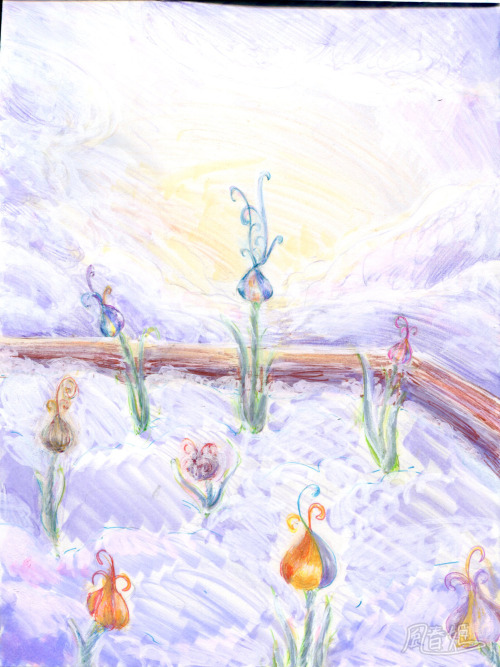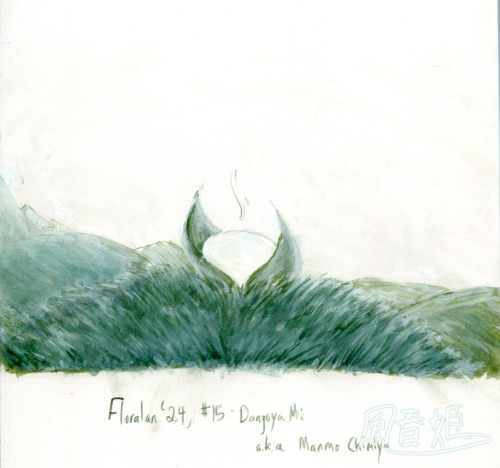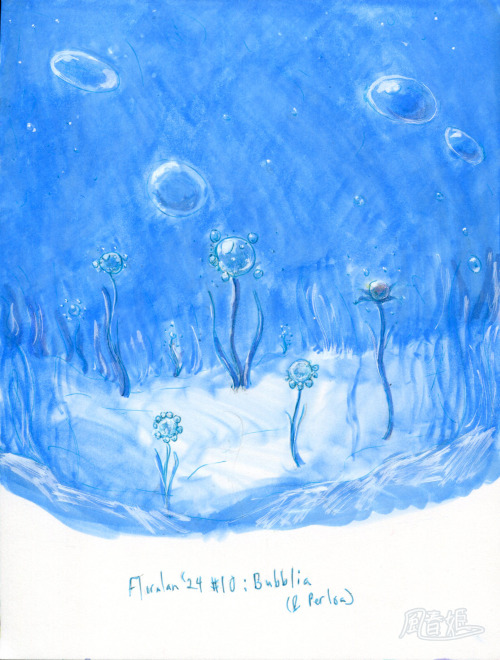Orbitania

Orbitania
The Orbitania is one of several specimens noted in last year's expedition to Hoshimi Island. From its dark stem color, a hypothesis has been put forth that it may originate from the Flyona line. Other evidence to support this idea is the faintly gummy, licorice-like taste of the stem, a trait which proper Flyona stems have in full. It would seem that other Hoshimi Island flora have a much stronger influence on it than any possible connections to the Flyona line, as its flowers share many of the characteristics of small, creeping vine flowers that were found growing near specimens such as the Spirra Starra, and its fruit bears resemblance to that of a Münlala Spikalif's. As far as the taste of the fruit goes, it was deemed unideal for eating. Like the Münlala's fruit, it proved to be hollow with a light fuzz over top. Light appears to emanate from this skin layer and not the inside, same as its relative's produce. Inside it is a small, dark flower. The fruit can be squeezed to produce water, but isn't particularly flavorful. The yellow petals, however, were noted to have a distinct sour note. The roots have a distinct spicy, radish-like taste when properly washed and prepared, though the upper root layer tends to be more like the stem.
-
 nessaspond liked this · 11 months ago
nessaspond liked this · 11 months ago -
 ciscandocinza liked this · 11 months ago
ciscandocinza liked this · 11 months ago -
 tzarina-alexandra reblogged this · 11 months ago
tzarina-alexandra reblogged this · 11 months ago -
 tzarina-alexandra liked this · 11 months ago
tzarina-alexandra liked this · 11 months ago -
 vaelzz liked this · 11 months ago
vaelzz liked this · 11 months ago -
 iggyfing liked this · 11 months ago
iggyfing liked this · 11 months ago -
 toothpaste-dragon liked this · 11 months ago
toothpaste-dragon liked this · 11 months ago -
 enjoliquej liked this · 11 months ago
enjoliquej liked this · 11 months ago
More Posts from Kazeharuhime

Twis-tia Petalia
Twis-tia Petalias were a once wild flowers that have been cultivated to grow in all sorts of different colors. The flower produces a nectar that hardens when exposed to air, producing a hard-candy-like substance within its flowers. The Twis-tia Petalia's close relative, the Sweetea Bundalia, does something similar, but has been cultivated to produce a hardening chocolate-like nectar instead of the honey-like substance that Twis-tia Petalias produce. As efforts to increase the number of Twis-tia Petalia and Sweetea Bundalia in JI continue, their delicious fruits can be expected to spread around JI as well.

Dangoya Mi a.k.a. Manmo Chimiya
Deeper exploration of the Reline Ah dimension (otherwise known as the Flower Buddy dimension) has revealed the existence of a misty land heated by geothermal heat on the border between it and the Fire Dimension. One plant that thrives here is the Dangoya Mi, or Manmo Chimiya. Its fruit, warmed by the ground, is piping hot and has a sticky consistency like that of a rice cake. When dried and fired, it can be drawn on, and residents of the land have been seen using them as decorations that way. As its taste is also similar to a sticky rice cake, it can be enjoyed as a savory item as well. The leaves that grow sheltering the fruit prove to be an artful decoration whether for use in serving or framing the dried fruit.

Bubblia (& Perloa)
Directly adjoining the Storm Dimension from beneath, there appears to be a previously unknown area of air sea. The air is so thick here it acts similar to a low-density ocean.
The first species to be recorded in this new area is the Bubblia. It would appear that the plant's smaller bubbles move about the surface of its larger one.
In some specimens, these bubbles followed a strict ring pattern, gliding about the surface of the nucleus bubble as a whole with the angle of this movement changing at random intervals. Whether the bubbles move clockwise or counter-clockwise seems to be connected to the water-air currents, switching when there's a shift in the current.
In other, larger specimens, these satellite bubbles were observed to each have their own path, which like the previously documented specimens, only switched their clockwise/counter-clockwise direction when the air-water currents shifted.
The the first type of specimens have been dubbled Ringia Bubblias. These were observed to have smaller central bubbles than the larger specimens with freer satellites.
Whether Ringia Bubblias are their own separate species or merely a juvenile version of the larger specimen type is still a topic of much debate, as there has yet to be observed any juveniles behaving like the larger specimen type.
On the one hand, there has been no noticeable change in behavior pattern of the known Ringia Bubblia specimens since their initial discovery. This does not discredit the notion of a maturation event still being on the horizon for any one of them, nor does it negate the possibility that the larger specimens are genetically nonviable offshoots of the Ringia Bubblia species, as it has yet to be observed how these larger specimens reproduce.
On the other, there are many indicators that Ringia Bubblias are the descendants of the larger specimens and not the other way around. For one thing, the larger specimens show evidence of being much older than the Ringias. The large specimens often have a somewhat central position in their patch, and tend to only exist in the singular per patch. This would give credence to the idea that the Ringias are desendants.
However, it still does not explain the behavioral differences and the fact that no Ringia has been observed maturing into the larger specimen type.
One hypothesis states that the larger specimen type acts as a sort of a queen or ruler over the smaller Ringias. This would explain why there can only be one large specimen type per patch.
It is also hypothesized that each satellite bubble on the larger specimen type corresponds to the movement of a ring somewhere in the patch, but this has yet to be sufficiently backed up with evidence.
Other than these two primary specimens, there has been another feature observed in Bubblia patches, and that is the presence of one of a third type of specimen, the Perloa, in every patch.
Unlike the first two, Perloas do not appear to be too closely related to either specimen type. They grow an opaquer, solider sphere in lieu of bubble nucleus and appear to maintain petal-like bracts even after fruiting. No external flowers were observed in either of the two Bubblia specimen types, and the primary bubble in each one seemed to form almost in place of sepals just below the base of flowers. Bubblias are thought to be related to Aquabulla genus by various points of evidence, and it is currently hypothesized that Perloas may be a hybird of the Perloa Alnia and Yura Aquabulla based on its appearance. However, this is at best speculation, and it is not yet clear if there really is a direct connection between the two species, or if they merely bear a resemblance to both and have a more indirect connection to the Aquabullas, much less the Perloa Alnias.
The fruit of the Perloa is not thought to be edible, but from their shiny appearance, it is thought they could become a collector's item in the future. This difference in taste is sometimes brought up as an argument against their being closely related to the Perloa Alnia, despite them both sharing the word "Perloa" in their name.

Higehige Plant
A houseplant domesticated in Reline Ah, the Higehige Plant was first discovered as a wild vine that grew along the ground. With a little care, it came to be cultivated indoors. As Reline Ah can be rather rainy, watering it is often as easy as setting the flowerpot outside for a bit. Due to the long dry seasons in northern Wing Alayna, it never quite took off there, and remains to be something enjoyed only by the resident Flower Buddys of Reline Ah.
How do you do the gradient colour text on tumblr?
Basically, I use this site to get a gradient text (to get more control over my gradient colors, I screenshot my draft post, load it up in PS [any program with layers, layer settings and gradients will work though], new layer set to screen, rectangle marquis the text, sample some colors from the pic for the gradient [or I might boost them/choose them myself/mess around with the sampled colors with color balance etc], apply gradient once or a few times to make adjustments if the initial one doesn't look nice [first is an opaque gradient, then one color with transparency to make adjustments unless it's really bad, then it's back to an opaque one and repeat process]. Once I'm happy with it I sample a color from each letter, line up the colors to sample from, then copy each hex code as I sample from the lineup and plug them into the site, adjusting for the number of letters), copy the html code once I'm happy with the gradient, then (on PC, but mobile browser works too) hit the gear on the top right corner of the draft editor, under text editor, hit the drop-down menu and select html. Go back to the draft editor, highlight the text to be gradiented, paste html in its place, hit the gear and go back to rich text under text editor, head back to the draft, see how it looks. If it looks bad, I go back into PS (or if you're not insane like me you could adjust it from the site, but I like knowing exactly what color what letter is going to be) and repeat the gradient and pasting processes. The process repeats until I'm happy with how it looks in the editor. Then I move on to finish the rest of my post